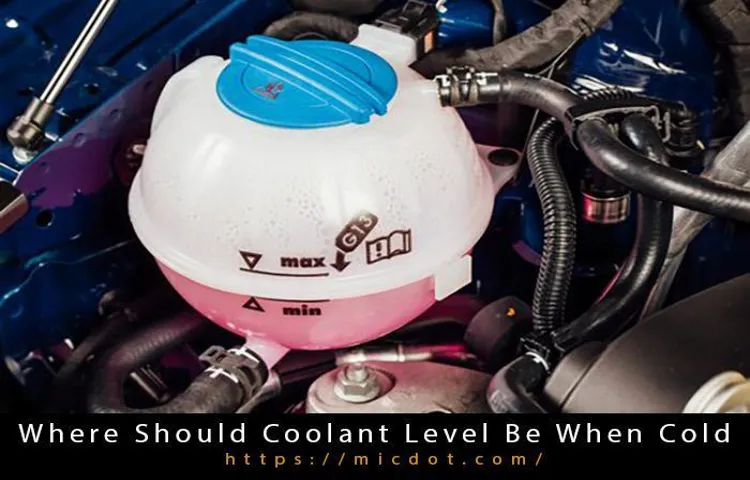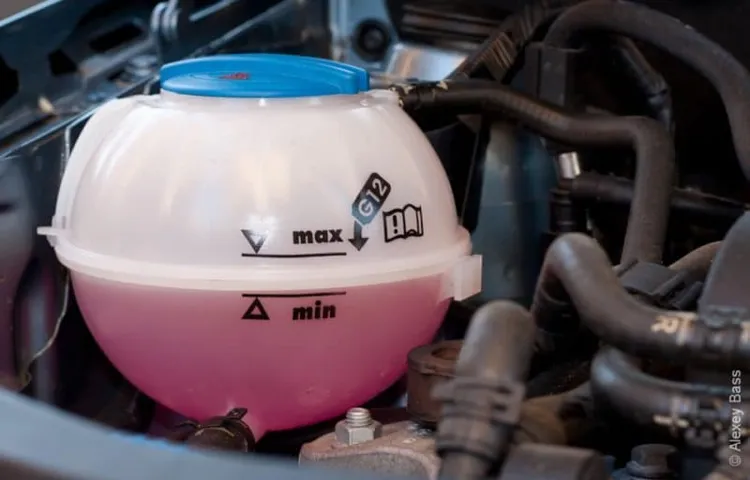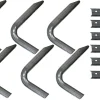Have you ever wondered what level your car’s coolant should be at? It’s a common question among drivers, but it’s essential to understand the importance of keeping your coolant levels in check. After all, the coolant plays a vital role in keeping your engine from overheating and preventing costly damage to your vehicle. In this blog post, we will answer the question, “What level should coolant be at?” and provide you with all the information you need to keep your engine running smoothly.
So buckle up, and let’s dive into the world of coolant levels!
Table of Contents
Understanding Coolant
When it comes to maintaining your vehicle’s engine, coolant is an essential element that requires attention. Coolant is responsible for keeping your engine from overheating and causing damage, making it important to know what level it should be at. Generally, the coolant level should be between the minimum and maximum marks on the coolant reservoir.
It’s important to ensure that your engine is cool before checking the coolant level and to only add coolant after it has been deemed low by the reservoir markings. Be sure to use the recommended type of coolant for your vehicle, as different makes and models require specific types. Checking the coolant level regularly and topping it off when necessary can help prevent issues and keep your engine running smoothly.
Composition of Coolant
Coolant is a vital component in an engine’s cooling system, and it’s essential to understand its composition. Coolant is typically made up of a mixture of ethylene or propylene glycol and water, with additives that enhance its performance. Glycol is a type of alcohol that can lower the freezing point and raise the boiling point of water, allowing the coolant to circulate even in extreme conditions.
By adding additives to coolant, its overall performance can be enhanced. For instance, additives such as rust inhibitors, pH balancers, and anti-foaming agents, among others, reduce the occurrence of overheating and corrosion of the engine’s components. A coolant’s concentration must always be in balance to optimize its effectiveness, and this balance is achieved through a hydrometer or refractometer.
In conclusion, understanding coolant and its composition is crucial to the proper functioning of an engine’s cooling system, and keeping a regular check on the coolant’s concentration and condition can aid in ensuring that the engine remains in peak condition.

Cooling System Overview
If you’re unfamiliar with your car’s cooling system, one component you need to understand is the coolant. Coolant is a liquid that circulates through different parts of your car’s engine, absorbing and dissipating heat before returning to the radiator to cool down. It’s made up of water and a mixture of chemicals that help prevent corrosion, rust, and engine boil-over, as well as lubricate the water pump.
Many people believe that water alone can be used as a coolant, but this is not recommended, especially in very cold weather. Radiator fluids are usually colored green, yellow, or red but can also take on other hues, depending on the brand or manufacturer. Coolant needs to be replaced regularly, especially if you live in extreme weather conditions, as it deteriorates over time and loses its effectiveness.
Regardless of the color or type of coolant you use, it’s crucial to maintain proper levels and keep your cooling system in tip-top shape to avoid costly repairs down the line.
Checking Coolant Level
When it comes to checking the coolant level in your vehicle, it’s essential to know what level it should be at to ensure your engine stays cool and runs optimally. The location of the coolant reservoir may vary from one car to another, so it’s best to consult your vehicle manual to locate it. Once you find it, remove the cap and visually inspect the coolant level.
The coolant should be within the minimum and maximum markings on the reservoir. If it’s lower than the minimum mark, add a 50/50 mixture of water and coolant until it reaches the recommended level. It’s important not to overfill the reservoir as this can lead to overflow and overheating.
Regularly checking your coolant level is a simple but crucial part of vehicle maintenance that can prevent costly engine repairs down the road.
Locating the Coolant Reservoir
When it comes to maintaining your vehicle, keeping an eye on the coolant level is crucial to prevent overheating and possible engine damage. To check your coolant level, you first need to locate the coolant reservoir. This container is typically translucent and located near the radiator or engine block.
Refer to your vehicle owner’s manual or online resources for specific instructions on where to find it. Once you’ve located the reservoir, check the coolant level by inspecting the markings on the container. If the level is below the minimum line, it’s time to add more coolant.
Be sure to use the recommended type of coolant for your specific vehicle make and model. Checking your coolant level regularly can help ensure safe and efficient operation of your vehicle, preventing costly repairs down the road.
Checking the Coolant Level
Checking the coolant level in your vehicle is an essential step in maintaining its performance and longevity. Coolant is responsible for keeping your engine from overheating, which could cause lots of problems. To check the coolant level, open the hood of your car and locate the coolant reservoir.
It should be clear or translucent with min/max markings. Ensure that the engine is cool before removing the cap and checking the level. If the coolant level is low, add more until it reaches the maximum level.
It’s essential to use the type of coolant specified by your vehicle manufacturer, and never mix different types of coolant. If you find that you need to refill the coolant reservoir frequently, it could be a sign of a leak, which should be addressed immediately to avoid engine damage. Checking your car’s coolant level doesn’t take much time and could save you significant problems down the road.
Adding Coolant if Necessary
Checking the coolant level in your car is critical to ensuring your engine runs smoothly. A low coolant level can cause your engine to overheat, and this can lead to permanent engine damage. Checking the coolant level is straightforward and can be done in a few simple steps.
Firstly, locate the coolant reservoir. The coolant reservoir is a small, plastic tank near the radiator. Once you’ve located the reservoir, make sure the engine is cool before opening the cap.
Look inside the reservoir and check the coolant level. The coolant level should be between the minimum and maximum lines indicated on the reservoir. If the level is below the minimum line, you’ll need to add more coolant.
Simply pour the coolant into the reservoir, but be sure not to overfill it. Finally, replace the cap, and you’re done! By checking your coolant level regularly and topping it up if necessary, you’ll help keep your engine running smoothly and prevent any costly engine damage.
Importance of Proper Coolant Level
Checking the coolant level in your vehicle is an essential maintenance task that shouldn’t be neglected. A low coolant level can cause severe engine damage, leading to costly repairs. So, what level should coolant be at? The ideal level is between the “minimum” and “maximum” marks on the coolant reservoir tank.
This level varies depending on the vehicle make and model, so it’s best to refer to your owner’s manual for specifics. A high coolant level can also cause problems, such as pressure build-up and leaks. It’s crucial to check the coolant level regularly, especially before long trips or extreme weather conditions.
Neglecting this simple task can have serious consequences, so stay on top of it and keep your engine running smoothly.
Effects of Low Coolant Level
Proper coolant level in a vehicle plays a critical role in maintaining the engine’s health, and ignoring it can lead to serious consequences. Low coolant levels can cause engine overheating and damage critical engine components such as the head gasket and cylinder heads. These damages will cost you a lot more than maintaining the proper coolant level.
It’s like having a doctor prescribe medication for an illness, but not following the dosage instructions. When you don’t put enough coolant in your vehicle, your engine can’t function at its best, just like your body can’t operate effectively without the right amount of medication. Therefore, it’s imperative to keep a check on the coolant level and add coolant as required.
Remember, a little maintenance now can save you a lot of repair expenses in the future.
Effects of Overfilling Coolant
Coolant Level Proper coolant level is essential for the optimal functioning of the engine. Overfilling coolant can cause many adverse effects. The engine may overheat, and the extra pressure built up due to overfilling can damage the coolant system’s components, such as the radiator, water pump, or hoses.
Moreover, the high pressure might even cause the coolant hose to burst. It can also lead to increased friction and wear and tear of the engine components, causing premature failure and costly repairs. Overfilled coolant can also lead to air pockets in the system, further reducing the cooling ability of the coolant.
It’s crucial to ensure adequate coolant levels, which should be maintained as per the manufacturer recommendations. The ideal level should be at the halfway mark between the “low” and “high” markings on the coolant reservoir. Only use the recommended coolant type and a 50/50 mix of coolant and water, unless the manufacturer specifies otherwise.
It’s always prudent to check the coolant level before every drive to keep the engine functioning at its best.
Conclusion
In the world of engine maintenance, much like in life, balance is key. When it comes to coolant levels, the sweet spot is right in the middle. Too high and you risk overflowing, too low and your engine could overheat and cause serious damage.
So, let’s take a cue from Goldilocks and aim for that “just right” level to keep our engines running smoothly. And remember, always consult your owner’s manual or trusted mechanic for the recommended level for your specific vehicle. Happy cruising!”
FAQs
What is the ideal coolant level in a car’s radiator?
The coolant level in a car’s radiator should be between the minimum and maximum marks on the reservoir.
How often should the coolant level be checked in a car?
It is recommended to check the coolant level in a car every time you have the oil changed or have your car serviced.
What do you need to check the coolant level in a car?
To check the coolant level in a car, you will need to open the hood, find the coolant reservoir, and visually inspect the fluid level.
Can you add water to the coolant in a car’s radiator?
It is possible to add water to the coolant in a car’s radiator if necessary, but it is recommended to use a coolant mixture that is specifically designed for your car.
What happens if the coolant level in a car is too low?
If the coolant level in a car is too low, it can cause the engine to overheat and potentially cause engine damage.
Is it normal for the coolant level to decrease over time?
It is normal for the coolant level to decrease slightly over time due to evaporation, but a significant decrease could indicate a leak or other issue.
Can you drive a car with low coolant?
It is not recommended to drive a car with low coolant as it can cause engine damage and potentially lead to a breakdown.


